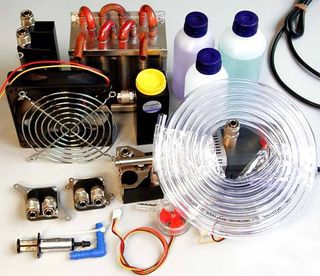The Third THG Video: Silent and Ice Cold
Silently Fighting Thermal Death: A PC With Water Cooling, Continued
Here, we ask the basic question: Why can't a PC do its job silently? The practical reasons for this are obvious: several active coolers (such as those on the processor, graphics card, chip set and power supply) make for a higher noise level on par with that found at a construction site. At the same time, there's a large amount of heat generated in the PC case, which, in turn, is dissipated with the help of additional fans on the chassis.
The result is that the computer ends up with at least eight fans that typically show signs of technical faultiness after only a few months of use. Our previous tests of fast PC systems have also proven that it's not possible to use conventional means to build a high-performance high-end PC system that is also silent.

An overview of all components needed to install water cooling in any PC system.
Actually, the creative impetus tends to come from smaller firms that offer kits for installing your own water cooling system. These companies have overcome the pubescent tinkering phase, and now, more mature solutions for professional and demanding users are available. The "bucket of water" method of yore is only used by a few freaks in their romper rooms.
Our message to you : All users can equip their PC systems with a highly efficient water cooling system in just a few steps, and with a little extra pocket change. Also, it can even be fun, especially if you're planning to overclock the processor to the limit. The result is a virtually noiseless PC system with high performance that the brand-name manufacturers can only dream about. Compared to the commonly available kits, we really take the full-power approach: apart from the processor, the graphics card, chipset and the hard drive are also cooled with water. Accompanying the article is a new Tom's Hardware Guide video.
Stay on the Cutting Edge
Join the experts who read Tom's Hardware for the inside track on enthusiast PC tech news — and have for over 25 years. We'll send breaking news and in-depth reviews of CPUs, GPUs, AI, maker hardware and more straight to your inbox.
Current page: Silently Fighting Thermal Death: A PC With Water Cooling, Continued
Prev Page Silently Fighting Thermal Death: A PC With Water Cooling Next Page THG Presents The Video In Three LanguagesMost Popular

